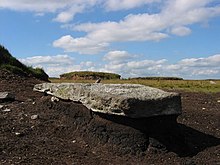Row of stones on Cut Hill
The prehistoric row of stones discovered in 2004 at Cut Hill in north Dartmoor in Devon , England, is the first row of stones that could be dated.
The nine overturned granite stones in the row were made before 3500 BC. Erected. First five, then nine stones were discovered and exposed. All are over 1.8 m long, 0.6 m wide and 20 cm thick. They are at a distance of 25.0 to 30.0 meters.
It seems that the originally erected stones were deliberately placed flat on the peat. This "fall of the megaliths", which has parallels in Brittany , took place around 3500 BC. The researchers found that the stones were completely covered in peat about 1000 years later, before they were exposed again by the recent erosion. The ability to date accurately is because there was peat under and over the stones.
The discovery is of international importance. There are hundreds of rows of stones and thousands of menhirs , particularly in the British Isles and northern France, and none have been previously dated. They were thought to date from the Bronze Age (around 2000 BC), but they date from the Middle Neolithic .
See also
Web links
Coordinates: 50 ° 37 ′ 40.3 " N , 3 ° 58 ′ 55.5" W.
